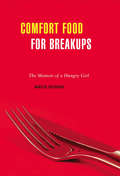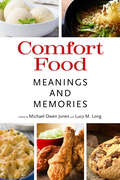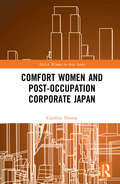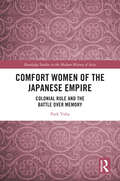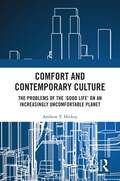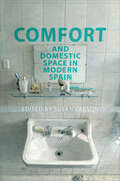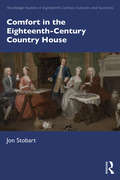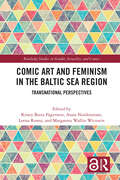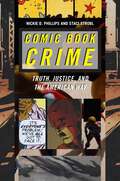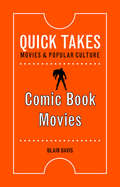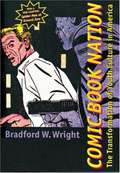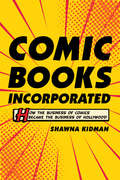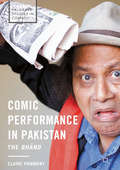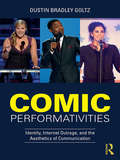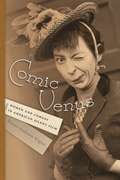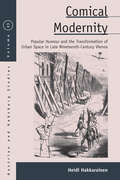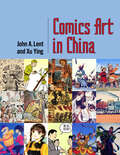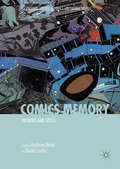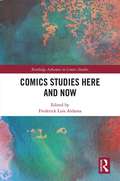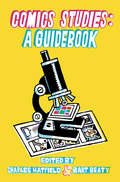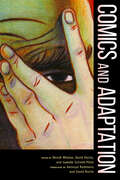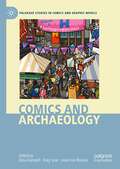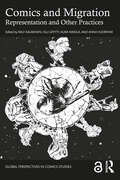- Table View
- List View
Comfort Food for Breakups
by Marusya BociurkiwAn elegiac memoir about food, family, and the thorns of personal history written by a Ukrainian Canadian lesbian, whose family recipes connect intimate vignettes in which food nourishes, comforts, and heals the wounds of the past, including those of a father haunted by memories of time spent in a concentration camp during World War II. The author, both at home and in her travels through North America and Europe, also reconciles her family life with her queer identity; food becomes her salvation and a way to engage with the world. Thoughtful, sensual, and passionate, Comfort Food for Breakups muses on the ways in which food intersects with a nexus of hungers: for intimacy, for family, for home. Marusya Bociurkiw is a filmmaker and the author of three previous books.
Comfort Food: Meanings and Memories
by Michael Owen Jones and Lucy M. LongWith contributions by Barbara Banks, Sheila Bock, Susan Eleuterio, Jillian Gould, Phillis Humphries, Michael Owen Jones, Alicia Kristen, William G. Lockwood, Yvonne R. Lockwood, Lucy M. Long, LuAnne Roth, Rachelle H. Saltzman, Charlene Smith, Annie Tucker, and Diane TyeComfort Food explores this concept with examples taken from Atlantic Canadians, Indonesians, the English in Britain, and various ethnic, regional, and religious populations as well as rural and urban residents in the United States. This volume includes studies of particular edibles and the ways in which they comfort or in some instances cause discomfort. The contributors focus on items ranging from bologna to chocolate, including sweet and savory puddings, fried bread with an egg in the center, dairy products, fried rice, cafeteria fare, sugary fried dough, soul food, and others.Several essays consider comfort food in the context of cookbooks, films, blogs, literature, marketing, and tourism. Of course what heartens one person might put off another, so the collection also includes takes on victuals that prove problematic. All this fare is then related to identity, family, community, nationality, ethnicity, class, sense of place, tradition, stress, health, discomfort, guilt, betrayal, and loss, contributing to and deepening our understanding of comfort food.This book offers a foundation for further appreciation of comfort food. As a subject of study, the comfort food is relevant to a number of disciplines, most obviously food studies, folkloristics, and anthropology, but also American studies, cultural studies, global and international studies, tourism, marketing, and public health.
Comfort Women and Post-Occupation Corporate Japan (ASAA Women in Asia Series)
by Caroline NormaThis book provides an overview of the Japanese sex industry in the years of Japan’s postwar economic boom. It argues that the origins of gender inequality in contemporary Japan resulted from the policies put in place during this period, when there was instituted a “sexual contract” which provided male salarymen whose work was arduous, underpaid and subject to military-like organisation with easy access to women’s bodies, through workplace getaway trips to hot springs resorts, hostess bars, and prostitution tourism to South Korea, as sexual inducement to acquiesce to their own exploitation. Japan’s economic growth, the book thereby contends, came at the price not just of environmental and labour degradation, but also gender inequality.
Comfort Women of the Japanese Empire: Colonial Rule and the Battle over Memory (Routledge Studies in the Modern History of Asia)
by Park YuhaThis is an important and controversial work, hitherto available only in Korean, Japanese, and Chinese, a book which has been subject to court cases attempting to have some parts deleted. The author reconsiders the issue of the “comfort women,” that is the Korean women who were compelled to provide sexual comfort to Japanese troops during the Asia-Pacific War. She explores the human complexity of the experiences of these women, who despite terrible exploitation, she feels, cannot and should not only be considered as passive victims. She sets the issue in context, revealing how Korean society played a role, with patriarchy and middlemen being significant factors in the procurement of comfort women, and how alongside the comfort women there were volunteer labor corps of Korean young women supporting the Japanese war effort. The author highlights Korea’s colonial status, different from the territories Japan invaded and conquered, discusses how relations between colonizers and colonized in an empire are not straightforward, and argues that people should work to understand more fully the mindset of those at the time, and refrain from forcing values from the present to resolve indignities of the past. Aiming to find a way to pursue reconciliation while looking more closely at the history, the book provides substantial consideration of key issues to do with empire, memorialization, and censorship. It is an uncomfortable read for those seeking simplistic interpretations and easy solutions.
Comfort and Contemporary Culture: The problems of the ‘good life’ on an increasingly uncomfortable planet
by Andrew HickeyTo be comfortable stands as an aspiration of the times; to be comfortable defines what it means to live ‘the good life’. We talk about such things as maintaining a comfortable home, a comfortable lifestyle and a comfortable retirement. We seek out comforts in the relationships we sustain, the leisure practices we enact and the possessions we accumulate. We look for promises of comfort in the words of a close friend and our next pair of shoes. Furnished in the home, optionally outfitted in cars, scrutinised in holiday brochures and brushed up against in the clothes we wear, comfort is there, marking distinctions and framing decisions about what it means to live well. But by consuming comfort in the ways that we do, we do ourselves harm and limit our only planet of its capacity to provide for the requirements of life. This is a world that grows ever more uncomfortable because of comfort and when linked to consumption and excess, indulgence and apathy, it occurs that comfort carries effects that have existential consequence. Utilising analyses of popular culture and ethnographic accounts of everyday life, Comfort and Contemporary Culture works through case study accounts of comfort’s enactment to pose questions around what it means to live, now. Comfort and Contemporary Culture poses alternative renderings of the idea of comfort to return the concept to its earliest roots in notions of confortāre. The revisioning of what we take as comfort requires urgent attention, with the ecological, social and intrapersonal implications of comfort’s current excesses demonstrative of this need. This book will be relevant reading for students and scholars of cultural studies and sociology, cultural anthropology, social geography and studies of community.
Comfort and Domestic Space in Modern Spain (Toronto Iberic #91)
by Susan LarsonComfort and domestic space are complex narratives that can help draw our attention to everything from urban planning, everyday objects, and new technologies to class conflict, racial and ethnic segregation, and the gendering of domestic labour. Comfort and Domestic Space in Modern Spain delves into the history of ideas surrounding the modern home. It explores how the collective experience of domestic space has been shaped by government ideologues, technocrats, and artists as well as working- and middle-class Spaniards since the late nineteenth century. The book focuses on the social and cultural meanings of domestic space in ways that invite us to cross boundaries between private and public, the particular and the general, the local and the global, and to pay attention to the role of the cultural imagination in making a house into a home. Considering a wide variety of voices and perspectives that have resulted in new ideas about how to inhabit domestic space, Comfort and Domestic Space in Modern Spain brings together an international, interdisciplinary group of scholars to illuminate the cultural history of everyday life.
Comfort in the Eighteenth-Century Country House (Routledge Studies in Eighteenth-Century Cultures and Societies)
by Jon StobartCountry houses were grand statements of power and status, but they were also places where people lived. This book traces the changes in layout, the new technologies, and the innovations in furniture that made them more convenient and comfortable. It argues that these material changes were just one aspect of comfort in the country house: feeling comfortable was just as important as being comfortable. Achieving this involved the comfort and solace to be found in daily routines, religious faith and, above all, relationships with family and friends. Such emotional comforts, and the attachment to things and places that embodied and memorialized them, made country houses into homes.
Comic Art and Feminism in the Baltic Sea Region: Transnational Perspectives (Routledge Studies in Gender, Sexuality, and Comics)
by Kristy Beers FägerstenThis edited collection explores how the relationship between comic art and feminism has been shaped by global, transnational, and local trends, curating analyses of multinational comic art that encompass themes of gender, sexuality, power, vulnerability, assault, abuse, taboo, and trauma. The chapters illuminate in turn the defining features of the aesthetics, materiality, and thematic content of their source material – often expressed with humorous undertones of self-reflection or social criticism – as well as recurring strategies of visualising and narrating female experiences. Broadening the research perspective of feminist comics to include national comics cultures peripheral to the cultural centers of Anglo-American, Franco-Belgian, and Japanese comics, the anthology explores how the dominant narrative or history of canonical works can be challenged or deconstructed by local histories of comics and feminism and their transnational connections, and how local histories complement or challenge the current understanding of the relationship between feminism and comic art. This is an essential collection for scholars and students in comics studies, women and gender studies, media studies, and literature.
Comic Art and Feminism in the Baltic Sea Region: Transnational Perspectives (Routledge Studies in Gender, Sexuality, and Comics)
by Kristy Beers FägerstenThis edited collection explores how the relationship between comic art and feminism has been shaped by global, transnational, and local trends, curating analyses of multinational comic art that encompass themes of gender, sexuality, power, vulnerability, assault, abuse, taboo, and trauma.The chapters illuminate in turn the defining features of the aesthetics, materiality, and thematic content of their source material – often expressed with humorous undertones of self-reflection or social criticism – as well as recurring strategies of visualising and narrating female experiences. Broadening the research perspective of feminist comics to include national comics cultures peripheral to the cultural centers of Anglo-American, Franco-Belgian, and Japanese comics, the anthology explores how the dominant narrative or history of canonical works can be challenged or deconstructed by local histories of comics and feminism and their transnational connections, and how local histories complement or challenge the current understanding of the relationship between feminism and comic art.This is an essential collection for scholars and students in comics studies, women and gender studies, media studies, and literature.The Open Access version of this book, available at http://www.taylorfrancis.com, has been made available under a Creative Commons Attribution-Non Commercial-No Derivatives (CC-BY-NC-ND) 4.0 license.
Comic Book Crime: Truth, Justice, and the American Way (Alternative Criminology #4)
by Nickie D. Phillips Staci StroblSuperman, Batman, Daredevil, and Wonder Woman are iconic cultural figures that embody values of order, fairness, justice, and retribution. Comic Book Crime digs deep into these and other celebrated characters, providing a comprehensive understanding of crime and justice in contemporary American comic books. This is a world where justice is delivered, where heroes save ordinary citizens from certain doom, where evil is easily identified and thwarted by powers far greater than mere mortals could possess. Nickie Phillips and Staci Strobl explore these representations and show that comic books, as a historically important American cultural medium, participate in both reflecting and shaping an American ideological identity that is often focused on ideas of the apocalypse, utopia, retribution, and nationalism. Through an analysis of approximately 200 comic books sold from 2002 to 2010, as well as several years of immersion in comic book fan culture, Phillips and Strobl reveal the kinds of themes and plots popular comics feature in a post-9/11 context. They discuss heroes’ calculations of “deathworthiness,” or who should be killed in meting out justice, and how these judgments have as much to do with the hero’s character as they do with the actions of the villains. This fascinating volume also analyzes how class, race, ethnicity, gender, and sexual orientation are used to construct difference for both the heroes and the villains in ways that are both conservative and progressive. Engaging, sharp, and insightful, Comic Book Crime is a fresh take on the very meaning of truth, justice, and the American way.
Comic Book Movies (Quick Takes: Movies and Popular Culture)
by Blair DavisComic Book Movies explores how this genre serves as a source for modern-day myths, sometimes even incorporating ancient mythic figures like Thor and Wonder Woman’s Amazons, while engaging with the questions that haunt a post-9/11 world: How do we define heroism and morality today? How far are we willing to go when fighting terror? How can we resist a dystopian state? Film scholar Blair Davis also considers how the genre’s visual style is equally important as its weighty themes, and he details how advances in digital effects have allowed filmmakers to incorporate elements of comic book art in innovative ways. As he reveals, comic book movies have inspired just as many innovations to Hollywood’s business model, with film franchises and transmedia storytelling helping to ensure that the genre will continue its reign over popular culture for years to come.
Comic Book Nation: The Transformation of Youth Culture in America
by Bradford W. WrightAs American as jazz or rock and roll, comic books have been central in the nation's popular culture since Superman's 1938 debut in Action Comics #1. Selling in the millions each year for the past six decades, comic books have figured prominently in the childhoods of most Americans alive today. In Comic Book Nation, Bradford W. Wright offers an engaging, illuminating, and often provocative history of the comic book industry within the context of twentieth-century American society. From Batman's Depression-era battles against corrupt local politicians and Captain America's one-man war against Nazi Germany to Iron Man's Cold War exploits in Vietnam and Spider-Man's confrontations with student protestors and drug use in the early 1970s, comic books have continually reflected the national mood, as Wright's imaginative reading of thousands of titles from the 1930s to the 1980s makes clear. In every genre-superhero, war, romance, crime, and horror comic books-Wright finds that writers and illustrators used the medium to address a variety of serious issues, including racism, economic injustice, fascism, the threat of nuclear war, drug abuse, and teenage alienation. At the same time, xenophobic wartime series proved that comic books could be as reactionary as any medium. Wright's lively study also focuses on the role comic books played in transforming children and adolescents into consumers; the industry's ingenious efforts to market their products to legions of young but savvy fans; the efforts of parents, politicians, religious organizations, civic groups, and child psychologists like Dr. Fredric Wertham (whose 1954 book Seduction of the Innocent, a salacious exposé of the medium's violence and sexual content, led to U. S. Senate hearings) to link juvenile delinquency to comic books and impose censorship on the industry; and the changing economics of comic book publishing over the course of the century.
Comic Books Incorporated: How the Business of Comics Became the Business of Hollywood
by Shawna KidmanComic Books Incorporated tells the story of the US comic book business, reframing the history of the medium through an industrial and transmedial lens. Comic books wielded their influence from the margins and in-between spaces of the entertainment business for half a century before moving to the center of mainstream film and television production. This extraordinary history begins at the medium’s origin in the 1930s, when comics were a reviled, disorganized, and lowbrow mass medium, and surveys critical moments along the way—market crashes, corporate takeovers, upheavals in distribution, and financial transformations. Shawna Kidman concludes this revisionist history in the early 2000s, when Hollywood had fully incorporated comic book properties and strategies into its business models and transformed the medium into the heavily exploited, exceedingly corporate, and yet highly esteemed niche art form we know so well today.
Comic Performance in Pakistan: The Bhānd (Palgrave Studies in Comedy)
by Claire PammentThis book explores comic performance in Pakistan through the vibrant Indo-Muslim tradition of the Punjabi bhānd which now holds a marginal space in contemporary weddings. With irreverent repartee, genealogical prowess, a topsy-turvy play with hierarchies and shape shifting, the low-status bhānd jostles space in otherwise rigid class and caste hierarchies. Tracing these negotiations in both historical and contemporary sites, the author unfolds a dynamic performance mode that travels from the Sanskrit jester and Sufi wise fool, into Muslim royal courts and households, weddings, contemporary carnivalesque and erotic popular Punjabi theatre and satellite television news. Through original historical and ethnographic research, this book brings to life hitherto unexplored territories of Pakistani popular culture and Indo-Muslim performance histories.
Comic Performativities: Identity, Internet Outrage, and the Aesthetics of Communication
by Dustin GoltzComic Performativities: Identity, Internet Outrage, and the Aesthetics of Communication studies patterns of criticism and public debate in the relationship between humour, identity, and offense. In an increasingly reductive and politically charged debate, right-wing pundits argue leftist politics has compromised a free and open discussion, while scholars take right-wing critics to task for reifying systems of oppression under the guise of reason and respect. In response, Goltz scrutinises twenty-first century "comedic controversies," the notion of "political correctness," and the so-called "outrage machine" of social media. How should we appropriately determine whether a joke is "sexist," "racist," or "offensive"? Informed by communication, performance, and critical identity theory, Goltz examines infamous controversies involving performers like Sarah Silverman, Amy Schumer, and Seth MacFarlane, and the social media backlash that redefined these events. He investigates the ironic interplay between spoken word, identity, physicality and, as a result, the contrasting meanings potentially construed. Consequently, the book encourages a greater appreciation of the aesthetics involved in comedic performance that help signpost interpretation and emphasizes the role of the audience as self-reflexive and self-aware. This book highlights the significant parallels between the nature of performance art and comedic performance in order to elevate analysis of, and discussion around, contemporary comedy. In doing so, it is an important critical contribution to the field of performance studies and cultural criticism, as well as communication studies, at both the undergraduate and postgraduate level.
Comic Venus: Women And Comedy In American Silent Film (Contemporary Approaches To Film And Media Ser.)
by Kristen Anderson WagnerFor many people the term “silent comedy” conjures up images of Charlie Chaplin’s Little Tramp, Buster Keaton’s Stoneface, or Harold Lloyd hanging precariously from the side of a skyscraper. Even people who have never seen a silent film can recognize these comedians at a glance. But what about the female comedians? Gale Henry, Louise Fazenda, Colleen Moore, Constance Talmadge—these and numerous others were wildly popular during the silent film era, appearing in countless motion pictures and earning top salaries, and yet, their names have been almost entirely forgotten. As a consequence, recovering their history is all the more compelling given that they laid the foundation for generations of funny women, from Lucille Ball to Carol Burnett to Tina Fey. These women constitute an essential and neglected sector of film history, reflecting a turning point in women’s social and political history. Their talent and brave spirit continues to be felt today, and Comic Venus: Women and Comedy in American Silent Film seeks to provide a better understanding of women’s experiences in the early twentieth century, and to better understand and appreciate the unruly and boundary-breaking women who have followed. The diversity and breadth of archival materials explored in Comic Venus illuminate the social and historical period of comediennes and silent film. In four sections, Kristen Anderson Wagner enumerates the relationship between women and comedy, beginning with the question of why historically women weren’t seen as funny or couldn’t possibly be funny in the public and male eye, a question that persists even today. Wagner delves into the idea of women’s “delicate sensibilities,” which presumably prevented them from being funny, and in chapter two traces ideas about feminine beauty and what a woman should express versus what these comedic women did express, as Wagner notes, “comediennes challenged the assumption that beauty was a fundamental component of ideal femininity.” In chapter three, Wagner discusses how comediennes such as Clara Bow, Marie Dressler, and Colleen Moore used humor to gain recognition and power through performances of sexuality and desire. Women comedians presented “sexuality as fun and playful, suggesting that personal relationships could be fluid rather than stable.” Chapter four examines silent comediennes’ relationships to the modern world and argues that these women exemplified modernity and new womanhood. The final chapter of Comic Venus brings readers to understand comediennes and their impact on silent-era cinema, as well as their lasting influence on later generations of funny women. Comic Venus is the first book to explore the overlooked contributions made by comediennes in American silent film. Those with a taste for film and representations of femininity in comedy will be fascinated by the analytical connections and thoroughly researched histories of these women and their groundbreaking movements in comedy and stage.
Comical Modernity: Popular Humour and the Transformation of Urban Space in Late Nineteenth Century Vienna (Austrian and Habsburg Studies #23)
by Heidi HakkarainenThough long associated with a small group of coffeehouse elites around the turn of the twentieth century, Viennese “modernist” culture had roots that reached much further back and beyond the rarefied sphere of high culture. In Comical Modernity, Heidi Hakkarainen looks at Vienna in the second half of the nineteenth century, a period of dramatic urban renewal during which the city’s rapidly changing face was a mainstay of humorous magazines, books, and other publications aimed at middle-class audiences. As she shows, humor provided a widely accessible means of negotiating an era of radical change.
Comics Art in China
by Ying Xu John A. LentInternational Convention of Asia Scholars 2019 Book Prize – Best Art PublicationIn the most comprehensive and authoritative source on this subject, Comics Art in China covers almost all comics art forms in mainland China, providing the history from the nineteenth century to the present as well as perspectives on both the industry and the art form. This volume encompasses political, social, and gag cartoons, lianhuanhua (picture books), comic books, humorous drawings, cartoon and humor periodicals, and donghua (animation) while exploring topics ranging from the earliest Western-influenced cartoons and the popular, often salacious, 1930s humor magazines to cartoons as wartime propaganda and comics art in the reform. Coupling a comprehensive review of secondary materials (histories, anthologies, biographies, memoirs, and more) in English and Chinese with the artists’ actual works, the result spans more than two centuries of Chinese animation. Structured chronologically, the study begins with precursors in early China and proceeds through the Republican, wartime, Communist, and market economy periods. Based primarily on interviews senior scholar John A. Lent and Xu Ying conducted with over one hundred cartoonists, animators, and other comics art figures, Comics Art in China sheds light on tumult and triumphs. Meticulously, Lent and Xu describe the evolution of Chinese comics within a global context, probing the often-tense relationship between expression and government, as well as proving that art can be a powerful force for revolution. Indeed, the authors explore Chinese comics art as it continues to grow and adapt in the twenty-first century. Enhanced with over one hundred black-and-white and color illustrations, this book stands out as not only the first such survey in English, but perhaps the most complete one in any language.
Comics Memory: Archives and Styles (Palgrave Studies in Comics and Graphic Novels)
by Maaheen Ahmed Benoît CrucifixDespite the boom in scholarship in both Comics Studies and Memory Studies, the two fields rarely interact—especially with issues beyond the representation of traumatic and autobiographical memories in comics. With a focus on the roles played by styles and archives—in their physical and metaphorical manifestations—this edited volume offers an original intervention, highlighting several novel ways of thinking about comics and memory as comics memory. Bringing together scholars as well as cultural actors, the contributions combine studies on European and North American comics and offer a representative overview of the main comics genres and forms, including superheroes, Westerns, newspaper comics, diary comics, comics reportage and alternative comics. In considering the many manifestations of memory in comics as well as the functioning and influence of institutions, public and private practices, the book exemplifies new possibilities for understanding the complex entanglements of memory and comics.
Comics Studies Here and Now (Routledge Advances in Comics Studies)
by Frederick Luis AldamaComics Studies Here and Now marks the arrival of comics studies scholarship that no longer feels the need to justify itself within or against other fields of study. The essays herein move us forward, some in their re-diggings into comics history and others by analyzing comics—and all its transmedial and fan-fictional offshoots—on its own terms. Comics Studies stakes the flag of our arrival—the arrival of comics studies as a full-fledged discipline that today and tomorrow excavates, examines, discusses, and analyzes all aspects that make up the resplendent planetary republic of comics. This collection of scholarly essays is a testament to the fact that comic book studies have come into their own as an academic discipline; simply and powerfully moving comic studies forward with their critical excavations and theoretical formulas based on the common sense understanding that comics add to the world as unique, transformative cultural phenomena.
Comics Studies: A Guidebook (Palgrave Studies In Comics And Graphic Novels Ser. #7)
by Mel Gibson Jan Baetens Darren Wershler Bart Beaty Philip Nel Frenchy Lunning Marc Singer Theresa Tensuan Benjamin Woo Ian Gordon Roger Sabin Gillian Whitlock Charles Hatfield Matthew P. McAllister Isaac Cates Brian MacAuley Andrei Molotiu Martha Kuhlman Kalervo Sinervo Shannon TienIn the twenty-first century, the field of comics studies has exploded. Scholarship on graphic novels, comic books, comic strips, webcomics, manga, and all forms of comic art has grown at a dizzying pace, with new publications, institutions, and courses springing up everywhere. The field crosses disciplinary and cultural borders and brings together myriad traditions. Comics Studies: A Guidebook offers a rich but concise introduction to this multifaceted field, authored by leading experts in multiple disciplines. It opens diverse entryways to comics studies, including history, form, audiences, genre, and cultural, industrial, and economic contexts. An invaluable one-stop resource for veteran and new comics scholars alike, this guidebook represents the state of the art in contemporary comics scholarship.
Comics Versus Art
by Bart BeatyOn the surface, the relationship between comics and the 'high' arts once seemed simple; comic books and strips could be mined for inspiration, but were not themselves considered legitimate art objects. Though this traditional distinction has begun to erode, the worlds of comics and art continue to occupy vastly different social spaces.Comics Versus Art examines the relationship between comics and the most important institutions of the art world; including museums, auction houses, and the art press. Bart Beaty's analysis centres around two questions: why were comics excluded from the history of art for most of the twentieth century, and what does it mean that comics production is now more closely aligned with the art world? Approaching this relationship for the first time through the lens of the sociology of culture, Beaty advances a completely novel approach to the comics form.
Comics and Adaptation
by Benoît Mitaine, David Roche and Isabelle Schmitt-PitiotContributions by Jan Baetens, Alain Boillat, Philippe Bourdier, Laura Cecilia Caraballo, Thomas Faye, Pierre Floquet, Jean-Paul Gabilliet, Christophe Gelly, Nicolas Labarre, Benoît Mitaine, David Roche, Isabelle Schmitt-Pitiot, Dick Tomasovic, and Shannon Wells-LassagneBoth comics studies and adaptation studies have grown separately over the past twenty years. Yet there are few in-depth studies of comic books and adaptations together. Available for the first time in English, this collection pores over the phenomenon of comic books and adaptation, sifting through comics as both sources and results of adaptation. Essays shed light on the many ways adaptation studies inform research on comic books and content adapted from them. Contributors concentrate on fidelity to the source materials, comparative analysis, forms of media, adaptation and myth, adaptation and intertextuality, as well as adaptation and ideology.After an introduction that assesses adaptation studies as a framework, the book examines comics adaptations of literary texts as more than just illustrations of their sources. Essayists then focus on adaptations of comics, often from a transmedia perspective. Case studies analyze both famous and lesser-known American, Belgian, French, Italian, and Spanish comics.Essays investigate specific works, such as Robert Louis Stevenson's The Strange Case of Dr. Jekyll and Mr. Hyde, the Castilian epic poem Poema de Mio Cid, Ray Bradbury's Martian Chronicles, French comics artist Jacques Tardi's adaptation 120, rue de la Gare, and Frank Miller's Sin City. In addition to Marvel Comics' blockbusters, topics include various uses of adaptation, comic book adaptations of literary texts, narrative deconstruction of performance and comic book art, and many more.
Comics and Archaeology (Palgrave Studies in Comics and Graphic Novels)
by Zena Kamash Katy Soar Leen Van BroeckThis book adds to the scant academic literature investigating how comics transmit knowledge of the past and how this refraction of the past shapes our understanding of society and politics in sometimes damaging ways. The volume comes at these questions from a specifically archaeological perspective, foregrounding the representation and narrative use of material cultures. It fulfils its objectives through three reception studies in the first part of the volume and three chapters by comic creators in the second part. All six chapters aim to grapple with a set of central questions about the power inherent in drawn images of various kinds.
Comics and Migration: Representation and Other Practices (Global Perspectives in Comics Studies)
by Ralf Kauranen Olli Löytty Aura NikkiläComics and human mobility have a long history of connections. This volume explores these entanglements with a focus on both how comics represent migration and what applied uses comics have in relation to migration. The volume examines both individual works of comic art and examples of practical applications of comics from across the world.Comics are well-suited to create understanding, highlight truthful information, and engender empathy in their audiences, but are also an art form that is preconditioned or even limited by its representational and practical conventions. Through analyses of various practices and representations, this book questions the uncritical belief in the capacity of comics, assesses their potential to represent stories of exile and immigration with compassion, and discusses how xenophobia and nationalism are both reinforced and questioned in comics. The book includes essays by both researchers and practitioners such as activists and journalists whose work has combined a focus on comics and migration. It predominantly scrutinises comics and activities from more peripheral areas such as the Nordic region, the German-language countries, Latin America, and southern Asia to analyse the treatment and visual representation of migration in these regions.This topical and engaging volume in the Global Perspectives in Comics Studies series will be of interest to researchers and students of comics studies, literary studies, visual art studies, cultural studies, migration, and sociology. It will also be useful reading for a wider academic audience interested in discourses around global migration and comics traditions.
